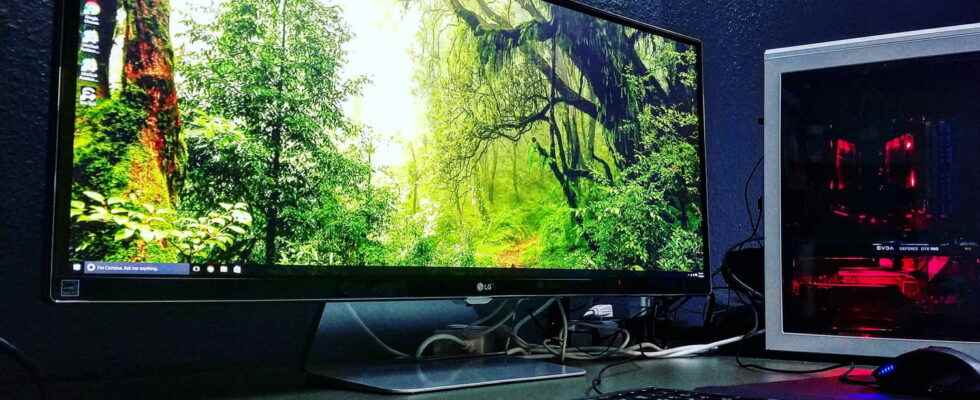The VESA association has just defined a new quality criterion for screens, ClearMR. Allowing to better measure their response time, it should give a reliable indication on the treatment of the famous motion blur.
Buying a TV or monitor is not an easy task. Each user has their own preferences and needs – not to mention the budget – and must therefore choose it according to their needs and the quality/price ratio. One of the recurring selection criteria for lovers of moving images – videographers but also, and above all, gamers – is fluidity, and, more specifically, the elimination of motion blur – motion blur in English – a very unpleasant effect at the visual level which results in streaks in the sequences displaying movements or rapid movements. However, for the association VESA (Video Electronics Standards Association), commonly used units of measurement, such as Motion Picture Response Time (MPRT) – which indicates in milliseconds the period during which a blur at the level of the edges of a horizontally moving image is observed –, do not take into account all the parameters of the blur, and therefore do not allow the consumer to realize account of the real quality of the screen.
That is why VESA has just defined a new quality index named ClearMR – Clear Motion Ratio. Its purpose is to become a new metric and benchmark, and to indicate a display’s ability to effectively eliminate this annoying blurring phenomenon. This new standard concerns all screens, whatever their technology – LCD, Oled, microLED, etc. – whether they are computer monitors, televisions, screens integrated into laptops or tablets.
Motion blur: a difficult effect to measure
Motion blur refers to the blurring phenomenon created by images that display rapid movement. It is linked to the response time of the screen (the famous MPRT), itself due to the change of state of the pixel. The lower the response time, the sharper the image, and therefore the better the visual comfort. For example, in a shooter, it’s easier to track moving targets without motion blur. Ditto for watching sports on television, in order to better follow the movements of players or racing cars, for example. Note that sometimes motion blur is deliberately created to simulate a speed and fast moving effect, such as in racing games.
But the problem according to VESA with the data provided by the manufacturers, such as the response time or the refresh rate, is that they are not sufficient. They “do not reflect the true nature of blur because a time-only metric cannot account for a number of image enhancement and blur mitigation techniques, such as overshoot and undershoot. -excessive overshoot, which can create artifacts and distortions that have negative effects.” Indeed, there are many technologies intended to compensate for motion blur. For example, Motion Blur Reduction is used on screens of various brands to improve the sharpness of images – at AOS it manifests itself via a monitor backlight system, which generates black images between the images delivered by the source, from synchronized way.
ClearMB: a new, less misleading indicator
To solve this problem, VESA decided to establish a new index called ClearMR, which “limits the use of these enhancement techniques during testing, allowing consumers to make a fair comparison of motion blur quality between VESA-certified ClearMR display products.” It is based on a numerical value measured as the ratio of sharp pixels to blurred pixels. Specifically, screens are tested using a high-speed camera. It takes pictures of a test pattern that moves across the screen as it moves from one image to another. A colorimeter is also used to measure the luminance of the pattern. The images captured by the camera are then analyzed to obtain the ClearMR value. Note that the screens are tested in a room at room temperature – manufacturers sometimes carry out measurements with totally unrealistic high ambient temperatures, because the response time improves when the screen gets hot –, at full resolution and with the highest refresh rate allowed. Backlight strobing features are disabled, so that testing can be performed in the same way on all screens, including those without these technologies, and viewing conditions are not distorted in an effort to obtain a better result, and therefore a certification.
The CMR value obtained corresponds to the ratio between clear pixels and blurred pixels, and makes it possible to obtain certifications ranging from ClearMR 3000 to ClearMR 9000. For example, ClearMR 2500 means that there are 25 times more clear pixels than blurred pixels. Similarly, ClearMR 5000 has 45 to 55 times more clear pixels than blurry pixels. The higher the value, the weaker the motion blur. Currently, the certification test can only be performed in SDR (standard dynamic range) mode, but VESA is working on a new version to perform the test in HDR (high dynamic range). All manufacturers can apply to participate in the program – this is already the case for LG and Samsung, two of the largest screen manufacturers, all categories combined. “With ClearMR, VESA provides the electronics industry with an open standard, ensuring consumers buy a TV, laptop or monitor that meets the most important blur criteria,” said Dale Stolitzka, principal researcher at the Samsung Display R&D Lab and one of the main contributors to ClearMR. “Supporting the VESA ClearMR program with a logo will allow consumers to feel confident in their purchase, knowing they are purchasing a display capable of clear representation even in moving scenes.”
